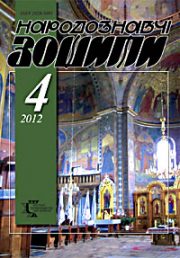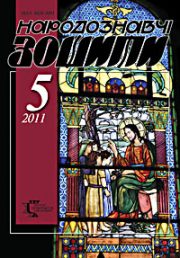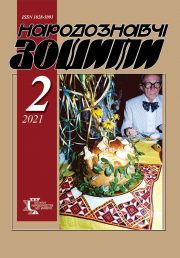The Ethnology Notebooks. 2023. № 1 (169), 193—206
UDK 069.5:391(=161.2)”17/18″
DOI https://doi.org/10.15407/nz2023.01.193
HERMINA OZARKEVYCH AND HER COLLECTION OF FOLK ARTWORKS
FEDORCHUK Olena
- ORCID ID: https://orcid.org/0000-0002-4724-3566
- Doctor of History (Dr. Sci.), Senior Researcher,
- Historical Ethnology Department,
- The Ethnology Institute of the National Academy of Sciences of Ukraine
- 15, Svobody Avenue, 79000, Lviv, Ukraine,
- Contacts: e-mail: folena@i.ua
Abstract. The article is devoted to the collecting activities of one of the representatives of the well-known in Galicia priestly Ozarkevichs family. The research is relevant given the importance of preserving, studying and multiplying the cultural heritage of Ukraine. The popularization of its results will contribute to the ethnic and national self-identification of Ukrainians.
The purpose of the article is to represent the activities of Hermina Ozarkevich (1865—1924) and to analyze her collection of rare ornamental samples of Ukrainian folk beaded jewelry and embroidery of the end of the XVIII — the second third of the XIX century.
During the 1880s—1910s, the collection was exhibited in Vienna, Prague, Krakow, Lviv, Kolomyia, Chernivtsi, and Ternopil, where it had great success. Additionally, it is known that H. Ozarkevich transferred personally collected artifacts to various museums.
Therefore, it is difficult to establish the exact total volume of artifacts. Up to now, the artifacts collected by H. Ozarkevich were discovered in one Prague and two Lviv museums.
Their visual analysis revealed valuable information about the technological, typological and stylistic features of the Ukrainian folk works, which are important material sources for the study of two ethnic artistic traditions — the tradition of bead decoration and the tradition of the embroidered decor of Ukrainian folk costumes.
The results of the study will be useful for researchers and followers of both mentioned traditions. Publication of the described results will contribute to the development of related scientific and artistic practices.
The article uses the method of biographical studies, the comparative method and the method of historical reconstruc tion.
Keywords: Ukraine, Hermina Ozarkevich, folk art, samples of gerdans, embroidery samples, Pokuttia, Bukovyna.
Received 27.11.2022
REFERENCES
- Kushnir, V. (2022). Interactivity, inclusion and participation as main lines of innovative practices of museum work. The Ethnology notebooks, 1 (163), 16—30 [in Ukrainian].
- Fedorchuk, O. (2017). The samples of gerdans from the collection of Hermina Ozarkevych-Velychko. Collection of reports and theses of the VII International Scientific and Practical Conference «Traditions and the Modern State of Culture and Arts»: in 2 vol. (Vol. 1, pp. 846—849). Minsk [in Russian].
- Fedorchuk, O. (2017). An unknown layer of the ethnographic collection of Frantisek Rehor (to the issue of Hermina Ozarkevych’s collection). «The Czech land gave us a man with a golden heart»: Frantisek Rehor in the paradigm of Ukrainian-Czech cultural relations: a collection of scientific works for the 160th anniversary of the birth of Frantisek Rehor (Pp. 95—104). Lviv [in Ukrainian].
- Fedorchuk, O., Bolyuk, O., Pohunek, J., & Valaskova, N. (2020). Traditional Folk Culture of Ukrainians in Austria-Hungary as Represented in the Ethnographic Collection of Frantisek Rehor from the 1880s and 1890s. Cesky Lіd, 1, 71—92. DOI: https://doi.org/10.21104/CL.2020.1.04 [in Czech].
- Skvorij, Roman (1995). Ozarkevych family. Bojky, 1—3, 32—35. Drohobych: Scientific and Cultural Society «Boikivshchyna» [in Ukrainian].
- Arsenych, P. (2010). The Ozarkevich family: 2nd edition. Sniatyn: Prut Print[in Ukrainian].
- Teofilia Okunevs’ka (Ozarkevych). Retrieved from: https://uk.rodovid.org/wk/Запис:728271 (Last accessed: 30.10. 2022) [in Ukrainian].
- Volodymyr Ozarkevych. Retrieved from: https://uk.rodovid.org/wk/Запис:728279 (Last accessed: 30.10.2022) [in Ukrainian].
- Natalia Ozarkevych (Kobryns’ka). Retrieved from: https://uk.rodovid.org/wk/Запис:728282 (Last accessed: 30.10.2022) [in Ukrainian].
- Longin Ozarkevych. Retrieved from: http://uk.rodovid.org/wk/Запис:728290 (Last accessed: 30.10.2022) [in Ukrainian].
- Shenderovskyi, Vasyl, & Kusherets, Vasyl. Yevhen Ozarkevych. Retrieved from: www.znannya.org.ua/index.php/about/znameniti-ukrajintsi/135-evgen-ozarkevich (Last accessed: 30.10.2022) [in Ukrainian].
- Yevhen Ozarkevych. Retrieved from: https://uk.rodovid.org/wk/Запис:728278 (Last accessed: 30.10.2022) [in Ukrainian].
- Hanitkevych, Yaroslav. Yevhen Ozarkevich — one of the founders of modern Ukrainian medicine (To the 150th anniversary of his birth). Scientific Society named after Shevchenko (Online magazine). Retrieved from: http://www.ntsh.org/content/ievgen-ozarkevich-odin-iz-zacnovnikiv-novitnoyi-ukrayinskoyi-medicini-do-150-richchya-vid#sthash.CVYm7DnM.dpuf (Last accessed: 30.10.2022) [in Ukrainian].
- Rovenchak, I. (2012). Cartographic heritage of H. Velychka. In: Doctor of Geography Hryhoriy Velichko (Pp. 47—55). Lviv: Ivan Franko National University of Lviv [in Ukrainian].
- Rovenchak, I.I. (2011). On the issue of ethnogeocultural cartographic analysis. In: Problems of continuous geographical education and cartography: Collection of scientific works (Issue 13, p. 85). Kharkiv: V.N. Karazin Kharkiv National University. Retrieved from: http://nbuv.gov.ua/UJRN/Pbgo_2011_13_28 (Last accessed: 30.10.2022) [in Ukrainian].
- Vis’tak, O. (2012). Chronology of life and activity. In: Doctor of Geography Hryhoriy Velichko (Pp. 56—57). Lviv: Ivan Franko National UniversityofLviv [in Ukrainian].
- Melnyk, Ihor. Hryhoriy Velychko is the first doctor of geography. Retrieved from: http://zbruc.eu/node/14402 (Last accessed: 30.10.2022) [in Ukrainian].
- Voloshyn, L. (2010). Olga Pleshkan. Lviv: Afisha [in Uk rainian].
- Petro Didushok. Retrieved from: https://uk.rodovid.org/wk/Запис:1305668 (Last accessed: 30.10.2022) [in Ukrainian].
- Franko, I.Ya. (1985). Ethnographic exhibition in Ternopil. Ivan Franko. Collection of works in fifty volumes (Vol. 46, book 1, pp. 469—479). Kyiv: Naukova dumka [in Ukrainian].
- Fedorchuk, O. (2021). The Tradition of Beaded Decoration in the Ukrainian Folk Costume (Based on the Materials from Western Regions of Ukraine). Lviv: Ethnology Institute of NAS of Ukraine [in Ukrainian].
- Franko, I.Ya. (2008). Galician-Ruthenian ornament at the Viennese exhibition [1886]. In: Ivan Franko. Additional volumes to the Collected Works in fifty volumes (Vol. 53, pp. 173—175). Kyiv: Naukova dumka [in Ukrainian].
- Valaskova, N. (1999). Frantisek Rehor (1857—1899) and his ethnographic activity (with examples of articles by F. Rehor from Galicia). Praha: Institute of Ethnology of the Academy of Sciences of the Czech Republic [in Czech].
- Fedorchuk, O. (2007). Ukrainian Folk Beaded Adornments. Lviv: Ethnology Institute of NAS of Ukraine; Swichado [in Ukrainian].
- Fedorchuk, O. (2017). Artistic tradition of Glass-bead’s Folk Clothes Decor from the Pokuttya. The Ethnology notebooks, 1 (133), 188—202 [in Ukrainian].







